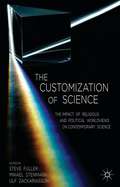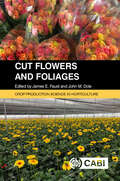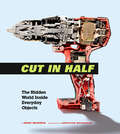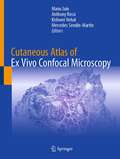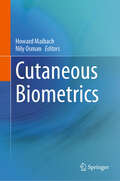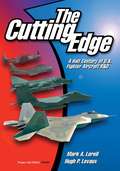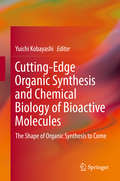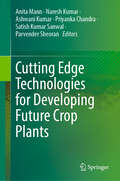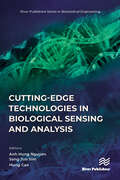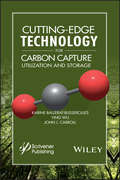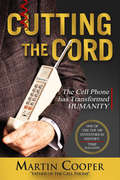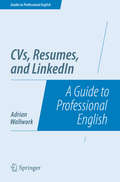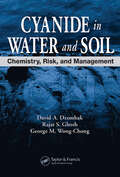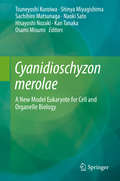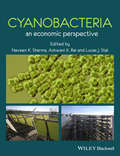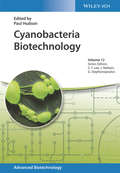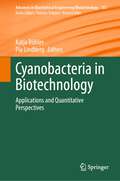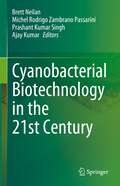- Table View
- List View
Customizable and Adaptive Quantum Processors: Theory and Applications
by Nadia Nedjah Luiza De Macedo MourelleThe book describes state-of-the-art advances in simulators and emulators for quantum computing. It introduces the main concepts of quantum computing, defining q-bits, explaining the parallelism behind any quantum computation, describing measurement of the quantum state of information and explaining the process of quantum bit entanglement, collapsed state and cloning. The book reviews the concept of quantum unitary, binary and ternary quantum operators as well as the computation implied by each operator. It provides details of the quantum processor, providing its architecture, which is validated via execution simulation of some quantum instructions.
The Customization of Science
by Steve Fuller Mikael Stenmark Ulf ZackariassonThis collection explores whether and how religious and secular worldviews and political ideologies held by scientists, citizens, decision-makers and politicians influence science as practiced and understood today. Contributors explore the social and scientific repercussions of 'customizing' science to fit the needs and interests of various groups.
Cut Flowers and Foliages (Crop Production Science in Horticulture)
by Raul I Cabrera Elizabeth Cieniewicz Melissa Muñoz Henry WainwrightThe cut flower and foliage industry is a global business with major production locations in North America, South America, Central America, East Africa, Europe, the Middle East, Asia, Australia and New Zealand. Few other horticulture crops are as ubiquitous, yet the production techniques and challenges are universal. This book describes the main international production locations and markets, including current trends and directions. The focus is on production in protected cultivation. The major species - including rose, chrysanthemum, carnation, orchid and gerbera - dominate the global market and these are individually explored in detail. Specialty species and cut foliages are also addressed, as well as significant details of production, including irrigation and fertilization, disease and disease management, and biological control of pests. Finally, the postharvest chapter covers details of harvesting, transporting and delivering high quality flowers that provide an excellent vase life. Highly illustrated with color photos throughout, this is an essential resource for students and researchers in horticulture, growers and producers, and those in the floriculture industry.
Cut in Half: The Hidden World Inside Everyday Objects
by Mike Warren Jonothan WoodwardWhat exactly is inside a laptop, a golf ball, a vacuum cleaner, or a novelty singing fish toy? The insides of these and dozens of other objects are revealed in this photographic exploration of the stuff all around us, exposed and explained. With the help of a high-pressure waterjet cutter able to slice through 4 inches of steel plate, designer and fabricator Mike Warren (creator of the popular Cut in Half YouTube channel) cuts into everything from boom boxes to boxing gloves, oil filters to seashells, describing and demystifying the inner workings and materials of each. With gorgeously detailed photography, Cut in Half is a fascinating and accessible popular science look at the extraordinary in the everyday.
Cutaneous Atlas of Ex Vivo Confocal Microscopy
by Manu Jain Anthony Rossi Kishwer Nehal Mercedes Sendín-MartínThis atlas provides a detailed overview of the novel technique of ex vivo confocal microscopy for rapid imaging of excised tissues in dermatological practice. It features an extensive collection of ex vivo images acquired from normal skin structures and from a variety of neoplastic lesions (benign and malignant) and inflammatory lesions. Each chapter contains several image types of a particular disorder, including gray-scale, digital purple-pink images (DHE) and hematoxylin and eosin (H&E) correlations to assist the acquisition of diagnostic skills. Guidance on how to use techniques for tissue preparation, staining, handling and image acquisition are also provided enabling the reader to develop confidence in integrating this technique into their day-to-day practices. Furthermore, this atlas also provides an update on the ongoing latest advances in the field. Cutaneous Atlas of Ex Vivo Confocal Microscopy covers how to apply these techniques into dermatological practice, especially in Mohs surgery for the evaluation of keratinocytic neoplasm and in dermatopathology for rapid evaluation of varied skin lesions. It is therefore a valuable resource for trainee, residents, practicing dermatologists and dermatopathologists who are seeking a resource to assist in developing their knowledge and skills of utilizing these methodologies.
Cutaneous Biometrics
by Howard Maibach Nily OsmanThis handbook covers the essential subject areas of cutaneous biometrics, including acne, aging, genetics, eczema, psoriasis, atopic dermatitis, rosacea, wound healing, and more. Erythema of rosacea and the risk of skin ulceration associated with oral nicorandil therapy are covered in detail. Various areas of acne are addressed, including acne severity grading, the assessment of general health and quality of life in patients with acne, and the effect of automated online counseling on clinical outcomes and quality of life among adolescents with acne vulgaris. Other topics include the development and validation of a clinical scale for the evaluation of forearm skin photoaging and a scoring system for mucosal disease severity. This is an ideal reference for biomedical engineering researchers and clinicians working in the field of dermatology interested in a deeper understanding of cutaneous biometrics and how it can be applied to their work. This book also: Broadens reader's understanding of the importance of creating meaningful dermatological patient outcome measurements and the use of the physician global assessment in a clinical setting to measure and track patient outcomes Details the guidelines on the measurement of ultraviolet radiation levels in ultraviolet phototherapy
Cute as an Axolotl: Discovering the World's Most Adorable Animals (The World of Weird Animals)
by Jess Keating"Cats of Instagram" meets National Geographic in this hilarious picture book about nature's cutest weirdos from the author of Pink Is for Blobfish!The Internet pretty much runs on cute animal photos, but "cute" is so much more than clickbait kittens and insta-pups. Cute is for feathery-gilled axolotls (pronounced: ax-uh-LOT-ulz), shy pygmy hippos, poisonous blue dragons, and armored pangolins. All of these animals are cute, but they've also adapted remarkable ways to survive in their unique environments. With her signature blend of humor and zoological know-how, Pink Is for Blobfish author Jess Keating shows how cute animals can be more than just a pretty face in this latest installment of the World of Weird Animals.
The Cutting Edge: Conserving Wildlife in Logged Tropical Forests (Biology and Resource Management Series)
by Fimbel Robert A. John G. Robinson Alejandro Grajal Eds.Recent decades have seen unprecedented growth in the scale and intensity of industrial forestry. Directly and indirectly, it has degraded the wildlife and ecological integrity of these tropical forests, prompting a need to evaluate the impact of current forest management practices and reconsider how best to preserve the integrity of the biosphere.Synthesizing the body of knowledge of leading scientists and professionals in tropical forest ecology and management, this book's thirty chapters examine in detail the interplay between timber harvesting and wildlife, from hunted and protected habitats to invertebrates and large mammal species.Collectively, the contributors suggest that better management is pivotal to the maintenance of the tropics' valuable biodiversity, arguing that we must realize that tropical forests harbor the majority (perhaps 70 to 80 percent) of the world's animal species. Further, they suggest modifications to existing practices that can ensure a better future for our valuable resources.
The Cutting Edge: A Half Century of U. S. Fighter Aircraft R and D
by Hugh P. Levaux Jennifer Gross Erik Moller Elizabeth Giddens Mark A. LorellThe proposition that innovation is critical in the cost-effective design and development of successful military aircraft is still subject to some debate. RAND research indicates that innovation is promoted by intense competition among three or more industry competitors. Given the critical policy importance of this issue in the current environment of drastic consolidation of the aerospace defense industry, the authors here examine the history of the major prime contractors in developing jet fighters since World War II. They make use of an extensive RAND database that includes nearly all jet fighters, fighter-attack aircraft, and bombers developed and flown by U.S. industry since 1945, as well as all related prototypes, modifications, upgrades, etc. The report concludes that (1) experience matters, because of the tendency to specialize and thus to develop system-specific expertise; (2) yet the most dramatic innovations and breakthroughs came from secondary or marginal players trying to compete with the industry leaders; and (3) dedicated military R&D conducted or directly funded by the U.S. government has been critical in the development of new higher-performance fighters and bombers.
Cutting-Edge Enabling Technologies for Regenerative Medicine (Advances in Experimental Medicine and Biology #1078)
by Heung Jae Chun Chan Hum Park Il Keun Kwon Gilson KhangThis book explores in depth the latest enabling technologies for regenerative medicine. The opening section examines advances in 3D bioprinting and the fabrication of electrospun and electrosprayed scaffolds. The potential applications of intelligent nanocomposites are then considered, covering, for example, graphene-based nanocomposites, intrinsically conductive polymer nanocomposites, and smart diagnostic contact lens systems. The third section is devoted to various drug delivery systems and strategies for regenerative medicine. Finally, a wide range of future enabling technologies are discussed. Examples include temperature-responsive cell culture surfaces, nanopatterned scaffolds for neural tissue engineering, and process system engineering methodologies for application in tissue development. This is one of two books to be based on contributions from leading experts that were delivered at the 2018 Asia University Symposium on Biomedical Engineering in Seoul, Korea – the companion book examines in depth novel biomaterials for regenerative medicine.
Cutting-Edge Organic Synthesis and Chemical Biology of Bioactive Molecules: The Shape of Organic Synthesis to Come
by Yuichi KobayashiThis book describes cutting-edge organic syntheses of biologically active compounds, isolation of pharmaceutically promising compounds from microorganisms, drug design, and progress on chemical biology. Synthetic strategy and tactics are summarized for super-carbon chain compounds, antitumor polycycles, aryl C-glycoside, antimycins, duocarmycins, cannabinoids, and other compounds. Special chapters are devoted to synthesis and biochemistry of fatty acid metabolites, which play a central role in the initiation and resolution of inflammation. The book provides a quick survey of trending topics in organic synthesis and chemical tools for biological investigation, and furnishes ideas for future research in organic synthesis. In addition, the contents can easily be understood by young chemists, graduate students, and those who are looking for new research based on organic chemistry.
Cutting Edge Technologies for Developing Future Crop Plants
by Anita Mann Naresh Kumar Ashwani Kumar Priyanka Chandra Satish Kumar Sanwal Parvender SheoranThis edited volume compiles recent advancements in techniques and technologies for sustainable crop production, focusing on innovative approaches to mitigate the adverse effects of environmental stress on crop productivity. The book offers a comprehensive overview of advanced physiological, molecular, agronomic, microbial, and breeding strategies designed to improve crop performance under stress conditions. It emphasizes high-throughput phenotyping and genotyping technologies, facilitating precise breeding for the development of climate-resilient crop varieties. The increasing impacts of climate change and global warming are now widely recognized as major threats to global food security, exacerbated by the depletion of natural resources essential for agricultural activities. With the world population projected to reach 10 billion by 2050, the scientific community is tasked with finding critical solutions to meet the growing demand for food. Addressing these challenges requires interdisciplinary approaches that integrate plant and soil systems, focusing on the development of sustainable, climate-smart agricultural practices. This volume explores technological interventions for managing degraded soils and water resources, optimizing nutrient management, leveraging microbial diversity, and employing nanobiotechnology for crop improvement. It also addresses the economics of agricultural investment, providing insights into the cost-effectiveness and sustainability of adopting climate-smart practices. The book offers a detailed analysis of the physiological, biochemical, and molecular mechanisms underlying plant responses to environmental stress, helping readers understand how plants adapt to adverse conditions. It also presents practical strategies for developing multi-stress-tolerant, climate-resilient crops, making it an invaluable resource for researchers, students, and professionals in agriculture, plant physiology, biochemistry, forestry, agronomy, soil science, and environmental sciences.
Cutting-edge Technologies in Biological Sensing and Analysis (River Publishers Series in Biomedical Engineering)
by Anh Hung Nguyen Sang Jun Sim Hung CaoAdvanced technologies have been transforming the ways we carry out biological studies as well as deliver healthcare. While micro- and nano-fabrication have provided miniaturized sensors and systems with better sensitivity and selectivity,; innovations in flexible electronics, biomaterials and telecommunications have helped in enabling novel biomedical devices, reducing cost, bringing convenience and establishing mobile-health (m-Health), and personalized- and tele-medicine. Further, the recent rise of the internet of things (IoTs) and machine learning-based approaches has paved the avenue for those biomedical systems to become popular and widely accepted by our society. In this context, we edit this book aiming to cover a broad field of novel technologies used in biological assessment and analysis for humans, animal models and in vitro platforms, in both health monitoring and biological studies. Technical topics discussed in the book include: Biosensing systems and biomedical techniques Imaging techniques and systems Biosignal analysis Animal models used in biological research
Cutting-Edge Technology for Carbon Capture, Utilization, and Storage (Advances in Natural Gas Engineering)
by Karine Ballerat-Busserolles Ying Wu John J. CarrollOf the 36 billon tons of carbon dioxide (CO2) being emitted into Earth’s atmosphere every year, only 40 million tons are able to be captured and stored. This is just a fraction of what needs to be captured, if this technology is going to make any headway in the global march toward reversing, or at least reducing, climate change. CO2 capture and storage has long been touted as one of the leading technologies for reducing global carbon emissions, and, even though it is being used effectively now, it is still an emerging technology that is constantly changing.This volume, a collection of papers presented during the Cutting-Edge Technology for Carbon Capture, Utilization, and Storage (CETCCUS), held in Clermont-Ferrand, France in the fall of 2017, is dedicated to these technologies that surround CO2 capture. Written by some of the most well-known engineers and scientists in the world on this topic, the editors, also globally known, have chosen the most important and cutting-edge papers that address these issues to present in this groundbreaking new volume, which follows their industry-leading series, Advances in Natural Gas Engineering, a seven-volume series also available from Wiley-Scrivener. With the ratification of the Paris Agreement, many countries are now committing to making real progress toward reducing carbon emissions, and this technology is, as has been discussed for years, one of the most important technologies for doing that. This volume is a must-have for any engineer or scientist working in this field.
Cutting Loose: Why Women Who End Their Marriages Do So Well
by Ashton ApplewhiteFor women contemplating divorce or for those who have already divorced, Ashton Applewhite’s insightful book sheds light on what to consider before making the decision to end your marriage, how to protect yourself—both financially and emotionally—and how much your life will change.One out of every two modern marriages ends in divorce, and 75 percent of those divorces are initiated by wives. Author Ashton Applewhite is one of these women, having sued for divorce after enduring an unfulfilling ten-year marriage. Cutting Loose is an essential resource for women who want to leave their marriage but fear the consequences.Shattering the media-generated image of the lonely, deprived and financially strapped divorcee, Applewhite provides a much needed reality check. Cutting Loose introduces 50 women, varying in age, race, class and predicament, who have thrived after initiating their own divorces. Their fears of financial, emotional and romantic ruin were never realized; on the contrary, their lives improved immeasurably, and their self-esteem soared.Cutting Loose also answers the crucial questions: How do you finally decide to make the big break? What is getting divorced really like? What are the shortcomings of the legal process? What about custody and child support? Financial and emotional survival? And how does a woman's self-image change during and after divorce? "Ending any kind of oppression takes belief in self. Cutting Loose offers moving evidence of how such belief works, whether in a relationship or walking the road alone. Perceptive, realistic, and wise, the book is of enormous practical value to both women and men who aspire to more equal and fulfilling relationships."—Laura Day, author of Practical Intuition
Cutting the Cord: The Cell Phone has Transformed Humanity
by Martin CooperOne of Time Magazine&’s Top 100 Inventors in History shares an insider&’s story of the cellphone, how it changed the world—and a view of where it&’s headed. While at Motorola in the 1970s, wireless communications pioneer Martin Cooper invented the first handheld mobile phone. But the cellphone as we know it today almost didn&’t happen. Now, in Cutting the Cord, Cooper takes readers inside the stunning breakthroughs, devastating failures, and political battles in the quest to revolutionize—and control—how people communicate. It&’s a dramatic tale involving brilliant engineers, government regulators, lobbyists, police, quartz crystals, and a horse. Industry skirmishes sparked a political war in Washington to prevent a monopolistic company from dominating telecommunications. The drama culminated in the first-ever public call made on a handheld, portable telephone—by Cooper himself. The story of the cell phone has much to teach about innovation, strategy, and management. But the story of wireless communications is far from finished. This book also relates Cooper&’s vision of the future. From the way we work and the way children learn to the ways we approach medicine and healthcare, advances in the cellphone will continue to reshape our world for the better.
CVs, Resumes, and LinkedIn: A Guide to Professional English (Guides to Professional English)
by Adrian WallworkAre you a graduate, postgraduate or PhD student? Are you simply looking for a new job in the private or public sector, in research or industry? If your aim is to produce a professional CV or resume, then this book is for you. Based on interviews with recruiters and HR managers, and an analysis of hundreds of CVs from around 40 different countries, the book is structured as a series of FAQs.Topics covered include:how recruiters and HR people analyse a CVwhether using a template is a good ideathe difference between a CV and a resumehow to present your personal details and whether to include a photohow to write an Executive Summarywhat to write in each section (Education, Work Experience, Skills, Personal Interests)how to write dateshow to highlight your language, communication and team skillshow to get and write referencesYou will also learn some hints and strategies for writing a:cover letterLinkedIn profilereference letterbioThe last chapter of the book contains a simple template to help you get the job of your dreams!
Cyanide in Water and Soil: Chemistry, Risk, and Management
by David A. Dzombak Rajat S. Ghosh George M. Wong-ChongPresenting the state-of-the-art in managing cyanide across a wide range of industrial and environmental contexts, this book brings together current knowledge about cyanide release to and behavior in the environment and explores how to control or remediate these releases. No other broad-based examination of this topic exists. The authors address the full range of issues pertaining to cyanide fate, transport, treatment, and toxicity in water and soil as well as approaches currently used in risk assessment and management. They have developed a careful balance of depth and scope of coverage, providing current references that help readers learn more about topics of particular interest.
Cyanidioschyzon merolae
by Tsuneyoshi Kuroiwa Shinya Miyagishima Sachihiro Matsunaga Naoki Sato Hisayoshi Nozaki Kan Tanaka Osami MisumiThis comprehensive book highlights the importance of Cyanidioschyzon merolae (C. merolae), an ultrasmall unicellular red alga, as a model eukaryote organism. The chapters introduce recent studies on C. merolae, from culture, synchronization and isolation methods of nucleic acids, proteins and organelles for molecular biological and cytological analyses, as well as its application in genetic engineering of environmental-stress-tolerant crops and oil production. In addition to discussing recent advances based on the complete genome information and molecular biological techniques such as genetic modifications and bioinformatics, the book includes visualization aids demonstrating that both classical and recent imaging techniques of fluorescent and electron microscopy can be applied to analyses of C. merolae. This publication offers a definitive resource for both beginners and professionals studying C. merolae, particularly in the field of molecular biology, evolutionary biology, morphology, biochemistry and cell biology, as well as those interested in its applications in medical sciences and agriculture.
Cyanobacteria
by Ashawani K. Rai Naveen K. Sharma Lucas J. StalWritten by leading experts in the field, Cyanobacteria: An Economic Perspective is a comprehensive edited volume covering all areas of an important field and its application to energy, medicine and agriculture.Issues related to environment, food and energy have presented serious challenge to the stability of nation-states. Increasing global population, dwindling agriculture and industrial production, and inequitable distribution of resources and technologies have further aggravated the problem. The burden placed by increasing population on environment and especially on agricultural productivity is phenomenal. To provide food and fuel to such a massive population, it becomes imperative to find new ways and means to increase the production giving due consideration to biosphere's ability to regenerate resources and provide ecological services.Cyanobacteria are environment friendly resource for commercial production of active biochemicals, drugs and future energy (biodiesel, bioethanol and hydrogen).Topics on isolation, identification and classification of cyanobacteria are discussed, as well as further sections on: summarizing a range of useful products synthesized by cyanobacteria, ecological services provided by cyanobacteria including their harmful effect in water bodies and associated flora and fauna. Chapter on tools, techniques, and patents also focus on the economic importance of the group. This book also provides an insight for future perspectives in each particular field and an extensive bibliography.This book will be a highly useful resource for students, researchers and professionals in academics in the life sciences including microbiology and biotechnology.
Cyanobacteria Biotechnology (Advanced Biotechnology)
by Sang Yup Lee Jens Nielsen Gregory StephanopoulosUnites a biological and a biotechnological perspective on cyanobacteria, and includes the industrial aspects and applications of cyanobacteria Cyanobacteria Biotechnology offers a guide to the interesting and useful features of cyanobacteria metabolism that keeps true to a biotechnology vision. In one volume the book brings together both biology and biotechnology to illuminate the core acpects and principles of cyanobacteria metabolism. Designed to offer a practical approach to the metabolic engineering of cyanobacteria, the book contains relevant examples of how this metabolic "module" is currently being engineered and how it could be engineered in the future. The author includes information on the requirements and real-world experiences of the industrial applications of cyanobacteria. This important book: Brings together biology and biotechnology in order to gain insight into the industrial relevant topic of cyanobacteria Introduces the key aspects of the metabolism of cyanobacteria Presents a grounded, practical approach to the metabolic engineering of cyanobacteria Offers an analysis of the requirements and experiences for industrial cyanobacteria Provides a framework for readers to design their own processes Written for biotechnologists, microbiologists, biologists, biochemists, Cyanobacteria Biotechnology provides a systematic and clear volume that brings together the biological and biotechnological perspective on cyanobacteria.
Cyanobacteria Biotechnology: Sustainability of Water-Energy-Environment Nexus
by Muhammad Aamer Mehmood Sana Malik Syed Ghulam Musharraf Ramaraj Boopathy“Dive into a Sustainable Future with Cyanobacteria Biotechnology” Explore the boundless potential of cyanobacteria in “Emerging Trends in Cyanobacteria Biotechnology”. This comprehensive volume, curated by leading experts, showcases cutting-edge research and practical applications across environmental sustainability, human health, and beyond. It will be the book of your choice to discover innovative methodologies and breakthroughs in carbon capture, bioprocessing, and metabolic engineering, illuminating cyanobacteria's pivotal role in shaping a sustainable future. Whether a researcher, student, entrepreneur, or industry professional, this book is your gateway to interdisciplinary collaboration and ground-breaking innovation. Join us on a journey to harness the power of cyanobacteria—let's build a healthier, more sustainable world together. Your next big idea starts here!
Cyanobacteria for Bioremediation of Wastewaters
by Inga Zinicovscaia Liliana CepoiThis book reflects the use of cyanobacteria for the bioremediation of wastewater through different mechanisms and pathways of transformation and transfer of hazardous substances from one medium to another. The application of microorganisms for bioremediation is determined by their ubiquity, small size, high rate of reproduction and large surface-to-volume cell ratio. Mechanisms of interaction of cyanobacteria with inorganic pollutants include biosorption, bioaccumulation with an opportunity to obtain metal nanoparticles both on the cell surface and inside the cells as well as chelation and inclusion of metals in the composition of certain organic structures. Data presented in the book provides specialists in the field with useful information for bioremediation technologies as well as for obtaining valuable preparations using cyanobacteria.
Cyanobacteria in Biotechnology: Applications and Quantitative Perspectives (Advances in Biochemical Engineering/Biotechnology #183)
by Katja Bühler Pia LindbergThis book provides a comprehensive and authoritative review of cyanobacteria and their applications as solar cell factories. Cyanobacteria are able to perform oxygenic photosynthesis and they are utilized in many different bioprocesses. The book covers two major aspects of a cyano-based bioprocess: the biological whole-cell catalyst and the technical environment in which the catalyst is applied. In the biocatalyst itself electron and carbon flow play an essential role for the performance of the cell and need to be tackled likewise for successful biocatalyst development. In the first chapters of this volume, cyanobacterial biotechnology and the fundamentals of cyanobacterial bioenergetics are introduced followed by an overview on tools and strategies for cyanobacteria engineering. Further on, examples of applications, engineering and production of different industrially relevant compounds in these organisms are provided, and finally process technology specific for cyanobacteria is covered. In this book, particular attention is given to topics such as cyanobacterial bioenergetics, metabolic engineering design strategies, utilizing cyanobacteria in biophotovoltaics, and production of pigments as well as photobiohydrogen in cyanobacteria, among others. This book will provide interested students and researchers in the area of photo-biotechnology with a deeper understanding of the cyanobacterial cell-factory, including the latest innovations and persistent challenges in the field.
Cyanobacterial Biotechnology in the 21st Century
by Brett Neilan Michel Rodrigo Zambrano Passarini Prashant Kumar Singh Ajay KumarThis book covers recent advances in cyanobacterial research. It deals with diversity, evolutionary biology, stress physiology, molecular biology of stress responses, and biotechnology of this group of prokaryotes. Cyanobacteria are ubiquitous and, undoubtedly, agriculturally microorganisms in terms of carbon and nitrogen fixation. In addition, cyanobacteria have long been used to fertilize crops and are a source of protein for humans. In parallel with the advances in cyanobacterial research in the 21st century, the development and application of innovative techniques in molecular biotechnology has widened the spectrum of commercial applications and potential exploitation of cyanobacteria. This book will be of interest to both new and experienced researchers involved in cyanobacterial molecular biology, ecology, and industrial biotechnology. This collection of chapters from experts also serves as essential reading for undergraduate and graduate students of to understand the importance of cyanobacteria in agriculture, ecology, microbial physiology, and environmental sciences.

